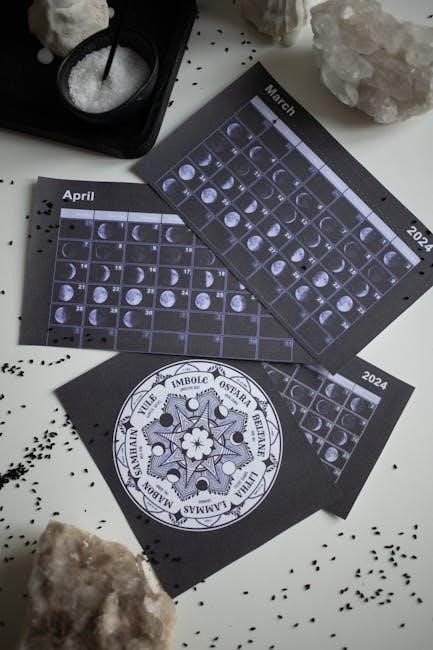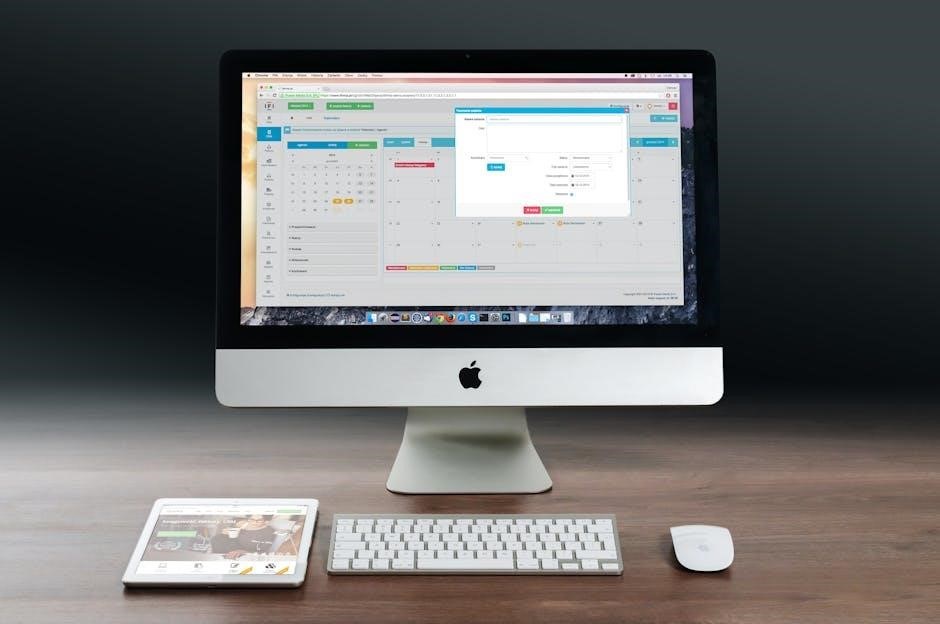The Julian Calendar PDF provides a historical and practical tool for tracking dates‚ featuring monthly layouts and perpetual designs. Download customizable templates for 2025 and 2026.
Overview of the Julian Calendar
The Julian Calendar is an ancient Roman calendar introduced by Julius Caesar in 45 BCE‚ designed to correct errors in the earlier Roman calendar. It features a 365-day year with a leap year every four years‚ adding an extra day in February. This system was widely used for centuries and remains significant in historical and astronomical contexts. The Julian Calendar PDF provides a structured format for tracking dates‚ with monthly layouts and perpetual designs. It differs from the modern Gregorian Calendar‚ primarily in leap year rules and date calculations. The Julian Calendar is still used today in certain religious and cultural traditions‚ as well as in astronomical calculations due to its consistent day numbering system.
Importance of the Julian Calendar PDF
The Julian Calendar PDF holds significant value for historical‚ cultural‚ and practical purposes. It provides a clear and organized format for tracking dates‚ essential for understanding historical events and religious traditions that still follow this system. The PDF serves as a reliable resource for astronomers‚ as the Julian Date remains a standard in astronomical calculations. Its portability and ease of use make it accessible for educational purposes‚ allowing users to explore the differences between ancient and modern calendars. Additionally‚ the Julian Calendar PDF is a valuable tool for planning and research‚ offering a consistent and accurate system for long-term date tracking and cultural studies.

History and Development of the Julian Calendar
The Julian Calendar‚ introduced by Julius Caesar in 45 BCE‚ reformed the Roman calendar to align with the solar year‚ establishing a 365-day cycle with a leap year every four years.
In 45 BCE‚ Julius Caesar introduced the Julian Calendar as part of a broader Roman calendar reform. Caesar‚ advised by astronomer Sosigenes‚ sought to correct the drift in the traditional Roman calendar‚ which had become misaligned with the solar year. The new system eliminated the lunar cycle’s influence‚ establishing a solar-based calendar with a 365-day year and a leap year every four years. This reform addressed the growing discrepancies in seasonal timing and brought stability to civil and religious scheduling. Caesar’s initiative marked a significant milestone in calendaring‚ laying the foundation for modern timekeeping. The Julian Calendar remained in use for over 1‚500 years‚ despite its slight inaccuracy in the solar year’s length‚ which was later corrected by the Gregorian Calendar.
Key Features of the Julian Calendar
The Julian Calendar‚ introduced by Julius Caesar in 45 BCE‚ features a solar-based system with a 365-day year and a leap year every four years. It eliminated the lunar cycle’s influence‚ establishing fixed month lengths that add up to 365 days. The leap year rule added an extra day in February every four years to maintain alignment with the solar year. However‚ the Julian Calendar has a slight error‚ accumulating an extra day every 128 years due to its leap year calculation. Despite this‚ it remained the standard for over 1‚500 years and influenced the development of later calendars. Its structure and simplicity made it a foundational system for modern timekeeping.
Historical Significance of the Julian Calendar
The Julian Calendar holds profound historical significance as a revolutionary reform of the traditional Roman calendar. Introduced by Julius Caesar in 45 BCE‚ it marked a shift from a lunar-based system to a solar-based one‚ aligning the calendar more closely with the Earth’s orbit. Its adoption standardized timekeeping across the Roman Empire‚ facilitating administration‚ trade‚ and cultural unity. The Julian Calendar remained in use for over 1‚500 years‚ influencing the development of modern calendars like the Gregorian. Its enduring legacy is evident in its continued use by some Eastern Orthodox churches and in astronomical calculations. The Julian Calendar’s impact on history is undeniable‚ shaping how civilizations track time and organize their lives.

Structure of the Julian Calendar PDF
The Julian Calendar PDF features a well-organized format with monthly layouts‚ numbered days‚ and a perpetual design‚ ensuring clarity and ease of use for planning purposes.
Monthly Layout and Day Numbers
The Julian Calendar PDF presents each month in a clear‚ grid-like layout‚ with days numbered sequentially from 1 to 31‚ depending on the month’s length. This structure ensures easy navigation and quick reference for users. The PDF typically displays seven columns for each day of the week‚ with weekends often highlighted for convenience. The layout is designed to maximize readability‚ with ample spacing between dates and events. Additional details‚ such as holidays or astronomical events‚ may be included alongside the day numbers. This format makes it ideal for planning and tracking appointments‚ tasks‚ or important dates. The simplicity of the design ensures that users can focus on essential information without clutter.
Perpetual Calendar Design
The Julian Calendar PDF incorporates a perpetual calendar design‚ allowing it to be used for any year by aligning the days of the week with the appropriate dates. This feature is particularly useful for long-term planning or historical research‚ as it eliminates the need for annual updates. The design typically includes a table or grid that highlights the cyclical nature of the calendar‚ making it easy to adjust for different years. The perpetual format ensures that users can reference dates across multiple years seamlessly. This timeless design makes the Julian Calendar PDF a versatile tool for both practical and academic purposes‚ ensuring its relevance beyond a single year.
Inclusion of Leap Years
The Julian Calendar PDF accounts for leap years‚ ensuring accuracy in its date calculations. A leap year occurs every four years‚ adding an extra day to February‚ making it a 29-day month. This adjustment prevents the calendar from drifting away from the Earth’s orbital period around the Sun. The PDF clearly highlights leap years‚ making it easier to track and plan for these extended years. This feature is essential for maintaining the calendar’s integrity and synchronization with astronomical events. The inclusion of leap years is a cornerstone of the Julian system‚ ensuring its reliability for both historical and future date tracking.

Downloading and Printing the Julian Calendar PDF
The Julian Calendar PDF is easily downloadable and printable‚ offering a convenient way to access its traditional layout. Compatible with various devices‚ it ensures seamless printing.
Steps to Download the PDF
To download the Julian Calendar PDF‚ visit a reliable source or official website offering the calendar. Ensure the version matches your desired year. Click the download link or button provided. Depending on the site‚ you may need to fill out a simple form or select specific options. Once the download begins‚ save the file to a convenient location on your device. Open the PDF using a compatible viewer like Adobe Acrobat. Review the calendar to confirm all details are correct before printing. Some sites may offer additional customization options or multiple layout choices. Always verify the source to ensure accuracy and avoid outdated versions. This process is quick and straightforward‚ allowing you to have a printable Julian Calendar PDF ready for use.
Printing Options and Customization
When printing the Julian Calendar PDF‚ choose high-quality paper for clarity. Select a printer with good resolution to ensure crisp text and numbers. Customize the layout by adjusting margins or scaling to fit your preferred paper size. Opt for portrait or landscape orientation based on your needs. You can also modify the color scheme to suit your preferences‚ using vibrant hues for holidays or important dates. Some templates allow adding personal notes or events. Use a PDF editor to tailor the design further‚ ensuring it aligns with your aesthetic or functional requirements. Print single months or the entire year at once. Always preview the PDF before printing to confirm the layout and content. These options make the Julian Calendar PDF adaptable for various uses.
Editable Templates for Personal Use
Editable Julian Calendar PDF templates allow users to personalize their calendars according to specific needs. These templates are designed to be user-friendly‚ enabling individuals to add custom events‚ notes‚ or holidays. Many templates include placeholders for important dates‚ such as birthdays or anniversaries‚ and offer the option to highlight specific days. Users can also modify fonts‚ colors‚ and layouts to suit their preferences. Some templates include space for adding personal goals or to-do lists‚ making them versatile for both planning and organization. Additionally‚ editable templates often support the inclusion of astronomical data‚ such as moon phases or zodiac signs‚ catering to diverse interests. This feature ensures the calendar remains adaptable and relevant for personal or professional use.

Julian Date Calendar for Specific Years
The Julian Date Calendar provides detailed yearly schedules for 2025‚ 2026‚ and future years beyond 2027. It offers customizable templates for precise date tracking and astronomical alignment.
2025 Yearly Julian Calendar
The 2025 Yearly Julian Calendar offers a comprehensive schedule for the year‚ detailing each month’s dates and days of the week. It begins with January 1‚ 2025‚ falling on a Tuesday. The calendar includes all significant holidays and astronomical events‚ ensuring alignment with the Julian system’s leap year rules. A notable feature is its compatibility with both digital and print formats‚ allowing users to customize layouts and colors. The 2025 Julian Calendar is particularly useful for historical tracking‚ astronomical calculations‚ and cultural planning. Its design ensures clarity and readability‚ making it a reliable tool for personal or professional use throughout the year.
2026 Yearly Julian Calendar
The 2026 Yearly Julian Calendar provides a detailed schedule for the entire year‚ starting with January 1‚ 2026‚ which falls on a Wednesday. This calendar includes all 12 months‚ with each month clearly indicating the days of the week and key dates. It incorporates notable holidays‚ religious observances‚ and astronomical events‚ making it a versatile tool for planning. The Julian Calendar’s leap year rule applies‚ ensuring accuracy in date calculations. Users can download the PDF for easy printing or digital use‚ with options to customize fonts and colors for better readability. The 2026 Julian Calendar is ideal for personal‚ educational‚ or religious purposes‚ offering a clear and organized layout for effective time management throughout the year.
Future Year Calendars (2027 and Beyond)
For planning beyond 2026‚ the Julian Calendar PDF offers templates for future years‚ starting from 2027. These calendars follow the same structure as previous years‚ ensuring consistency in layout and design. The leap year rule of the Julian Calendar is applied‚ maintaining accuracy in date calculations. Users can download and customize these PDFs for personal‚ educational‚ or professional use. Future year calendars are particularly useful for long-term planning‚ astronomical calculations‚ and historical research. They provide a reliable framework for organizing events and appointments well in advance. The Julian Calendar’s timeless design ensures that these PDFs remain a practical tool for years to come‚ adapting seamlessly to future needs and technological integrations.

Julian Calendar vs. Gregorian Calendar
The Julian and Gregorian calendars differ primarily in leap year calculations‚ causing a 13-day discrepancy over centuries. The Gregorian corrected the Julian’s leap year error‚ refining accuracy for modern use.
Differences in Date Calculation
The Julian and Gregorian calendars differ in how they calculate dates‚ primarily due to variations in leap year rules. The Julian calendar adds a leap day every four years‚ while the Gregorian omits three leap days every 400 years. This discrepancy results in a 13-day difference between the two calendars over time. The Julian calendar calculates the solar year as 365.25 days‚ while the Gregorian refines it to 365.2425 days‚ improving accuracy. These differences affect date alignments‚ particularly in historical and astronomical contexts. The Gregorian calendar is widely adopted today‚ but the Julian remains relevant for specific cultural and religious purposes. Understanding these differences is crucial for accurate date calculations in various applications.
Leap Year Variations
The Julian and Gregorian calendars differ in their handling of leap years‚ which affects date calculations. The Julian Calendar includes a leap year every four years without exception‚ while the Gregorian Calendar skips three leap years every 400 years. This means that in the Gregorian Calendar‚ years divisible by 100 are not leap years unless they are also divisible by 400. For example‚ 1900 was not a leap year in the Gregorian Calendar‚ but 2000 was. These variations result in a 13-day difference between the two calendars over time. The Gregorian Calendar’s refined leap year rule improves accuracy‚ reducing the error rate compared to the Julian Calendar’s simpler system.
Modern Relevance of the Julian Calendar
The Julian Calendar remains relevant today‚ particularly in religious and cultural contexts. Many Eastern Orthodox churches still use it to determine important dates like Easter. Its historical significance also appeals to scholars and enthusiasts studying ancient timekeeping systems. Additionally‚ the Julian Calendar’s structure‚ such as its leap year rules and monthly layout‚ continues to influence modern calendar designs. While the Gregorian Calendar is more widely used‚ the Julian Calendar’s legacy endures‚ offering a connection to the past and preserving traditional practices. Its PDF versions are popular for educational purposes‚ historical research‚ and cultural celebrations‚ ensuring its continued utility in contemporary society.

Using the Julian Calendar PDF
The Julian Calendar PDF is ideal for planning and organization‚ offering a clear‚ structured format. It’s perfect for personal or professional use‚ combining historical accuracy with practicality.
Practical Applications
The Julian Calendar PDF offers versatile and practical uses‚ combining historical accuracy with modern convenience. It serves as an essential tool for astronomers‚ historians‚ and educators‚ providing a reliable framework for date calculations and event planning. For astronomers‚ it aligns with celestial observations and long-term astronomical cycles. Historians and researchers benefit from its consistency in studying past events and timelines. Additionally‚ it is useful for religious institutions requiring adherence to traditional liturgical schedules. Individuals can use it for personal planning‚ genealogy research‚ or thematic events. Its simplicity and readability make it ideal for educational purposes‚ while its historical significance adds value to cultural and academic projects.
How to Customize the PDF
Customizing the Julian Calendar PDF is straightforward‚ allowing users to tailor it to their specific needs. Editable templates enable individuals to add personal notes‚ highlight important dates‚ or insert events. Digital tools like Adobe Acrobat or libreOffice can be used to modify the content. Users can also adjust fonts‚ colors‚ and layouts to enhance visual appeal. For added functionality‚ additional pages or sections can be included‚ such as holiday lists or historical notes. This flexibility makes the PDF adaptable for personal‚ educational‚ or professional use. By saving the customized version‚ users can easily share it or print it for future reference‚ ensuring it meets their unique requirements.
Integration with Digital Tools
Integrating the Julian Calendar PDF with digital tools enhances its functionality and accessibility. Users can import the PDF into apps like Google Calendar or Apple Calendar for seamless synchronization. Tools like Adobe Acrobat enable annotations and notes directly on the document. Additionally‚ PDFs can be converted to interactive formats for digital planning. Cloud storage services allow easy access across devices‚ ensuring the calendar is always available. Some platforms offer plugins to sync the Julian Calendar with modern digital tools‚ making it practical for both historical and contemporary use. This integration bridges tradition with modern technology‚ providing a versatile solution for diverse users.

Design and Layout Considerations
A well-designed Julian Calendar PDF features a clean layout‚ high-resolution images‚ and clear typography. Proper spacing ensures readability‚ while navigation tools like bookmarks enhance usability. Color schemes matter.
Visual Appeal and Readability
A Julian Calendar PDF should prioritize visual appeal and readability to ensure user satisfaction. High-contrast color schemes enhance readability‚ while clean layouts prevent clutter. Consistent font styles and sizes maintain professionalism. Proper grid alignment and spacing ensure dates are easily distinguishable. Incorporating subtle visual elements‚ like icons or images‚ can enhance engagement without overwhelming the user. Responsive design ensures the calendar looks sharp on all devices‚ from desktops to mobile screens. Optional headers or footers can provide additional information without compromising readability. Bold or italicized text can highlight important dates‚ such as holidays or leap years‚ making them stand out. These design considerations ensure the Julian Calendar PDF is both functional and aesthetically pleasing.
Inclusion of Additional Information
The Julian Calendar PDF can be enhanced by incorporating supplementary details to improve its utility. Adding historical notes or astronomical data‚ such as planetary alignments‚ can cater to users with specialized interests. Cultural or religious events tied to specific dates can also be included for broader relevance. Space for personal notes or reminders can make the calendar more interactive and customizable. Additionally‚ including instructions or conversion tools for switching between Julian and Gregorian calendars can add value. These enhancements ensure the PDF serves diverse needs while maintaining its core functionality. Balancing extra content with simplicity is key to preserving the calendar’s clarity and appeal.
Font and Color Choices
Choosing the right fonts and colors is essential for ensuring the Julian Calendar PDF is both readable and visually appealing. Opt for clean‚ legible fonts like Times New Roman or Arial‚ which are ideal for printed materials. Sans-serif fonts‚ such as Helvetica‚ are also suitable for digital viewing. Color schemes should be subtle‚ with high contrast between text and background to enhance readability. Consider using light backgrounds with dark text for better clarity. Avoid overly vibrant colors that may distract from the calendar’s functionality. Additionally‚ ensure that colors are accessible for individuals with color vision deficiency. Consistent typography and color choices will make the Julian Calendar PDF professional and user-friendly.

Julian Calendar PDF for Astronomy
The Julian Calendar PDF is a valuable tool for astronomers‚ offering a standardized system for tracking dates and calculating celestial events with precision and historical accuracy.
Julian Date in Astronomy
The Julian Date (JD) is a continuous count of days since January 1‚ 4713 BC‚ making it a cornerstone for astronomical calculations. It eliminates calendar discrepancies‚ providing a uniform timescale for celestial event predictions‚ such as planetary alignments or eclipses. Astronomers rely on JD for precise timing‚ as it avoids issues like leap years and varying month lengths. The Julian Calendar PDF often includes JD conversion tables or calculators‚ enabling seamless switching between Gregorian dates and JD; This tool is indispensable for accurately scheduling observations and modeling astronomical phenomena over centuries. Its precision ensures consistency across historical and future astronomical studies‚ making it a vital resource for researchers and enthusiasts alike.
Conversion Tools and Resources
Julian Calendar PDFs often include conversion tools to switch between Gregorian and Julian dates seamlessly. Online converters and downloadable software are widely used for precise date transformations. These tools account for the 13-day difference between the two calendars and are essential for historical research and astronomical calculations. Additionally‚ printable conversion charts and tables are provided in the PDF‚ allowing users to manually convert dates without digital assistance. Scripting libraries in languages like Python or JavaScript are also available for automating conversions in custom applications. These resources ensure accuracy and efficiency‚ making the Julian Calendar PDF an invaluable asset for scholars‚ astronomers‚ and historians alike.
Importance for Astronomical Calculations
The Julian Calendar holds significant importance in astronomical calculations due to its consistent and predictable structure. Unlike the Gregorian Calendar‚ the Julian system avoids irregularities like century leap year rules‚ providing a uniform timekeeping framework. Astronomers rely on Julian dates for precise calculations‚ such as determining planetary positions‚ orbital mechanics‚ and celestial event timing. The Julian Day Number (JDN) system‚ derived from the Julian Calendar‚ offers a continuous count of days since a starting point in 4713 BCE‚ eliminating fractional days and simplifying complex computations. This makes the Julian Calendar PDF an essential resource for astronomers needing accurate‚ long-term chronological data for research and predictions.

Tips for Effective Use
- Print the Julian Calendar PDF on high-quality paper for clarity.
- Use binders or spiral binding for easy flipping.
- Keep a digital backup for quick access.
- Sync with digital tools for seamless integration.
These tips enhance usability and organization‚ making the Julian Calendar PDF a practical tool for planning and reference.
Best Practices for Printing
When printing the Julian Calendar PDF‚ ensure optimal quality by using high-resolution settings. Choose A4 or letter-sized paper for clarity and ease of reading. Print on both sides to save paper and maintain organization. For durability‚ consider laminating or using cardstock for the cover page. Bind the pages using a spiral or comb binder for easy flipping. Adjust print settings to avoid scaling‚ as this can distort the layout. Use a consistent color scheme to maintain visual appeal. Finally‚ proofread the calendar before printing to catch any errors. These practices ensure a professional and functional Julian Calendar for everyday use.
How to Share the PDF
Sharing the Julian Calendar PDF is straightforward and convenient. For digital sharing‚ upload the file to cloud storage platforms like Google Drive or Dropbox and share the link via email or messaging apps. Social media platforms also allow easy distribution. For physical sharing‚ print multiple copies and distribute them in community centers‚ libraries‚ or offices. Ensure the PDF is high-resolution for clarity. When sharing digitally‚ consider password-protecting the file for security. Additionally‚ embed the PDF on websites or blogs to reach a wider audience. Always verify the file’s integrity before sharing to avoid errors. This ensures the Julian Calendar PDF is accessible and user-friendly for everyone.
Advantages Over Digital Calendars
The Julian Calendar PDF offers several advantages over digital calendars. It provides a tangible‚ print-friendly format‚ allowing users to have a physical copy for easy reference. PDFs are universally compatible and can be accessed without internet connectivity‚ making them ideal for offline use. They also offer consistent formatting across devices‚ ensuring readability and visual appeal. Additionally‚ PDFs can be easily annotated or printed for personal use‚ offering a level of customization that digital calendars may lack. The ability to save and share PDFs locally without relying on cloud services adds to their convenience. Overall‚ the Julian Calendar PDF is a reliable‚ accessible‚ and user-friendly alternative to digital options.
